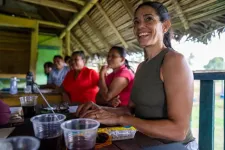(Press-News.org)
by Brooke McDonald
It turns out a common cockroach found across the globe is a pest of our own making.
In a study recently published in Proceedings of the National Academy of Sciences, Texas A&M AgriLife researchers unveiled insights into the origins of the common German cockroach, Blattella germanica.
The study, “Solving the 250-year-old mystery of the origin and global spread of the German cockroach, Blatella germanica,” included Edward Vargo, Ph.D., professor and endowed chair of urban entomology in the Texas A&M College of Agriculture and Life Sciences Department of Entomology.
Texas A&M AgriLife researchers, including Edward Vargo, Ph.D., have traced the German cockroach’s origins to Asia, revealing its evolutionary adaptation to human habitats, as detailed in their study recently published in the Proceedings of the National Academy of Sciences.
For centuries, the German cockroach has thrived in close proximity to human populations, infesting homes, apartment buildings, work offices and other structures.
“Unlike many other pest species, which have natural populations in diverse habitats, German cockroaches have no known natural populations,” Vargo said. “They rely solely on human activity and manmade structures.”
Evolution that spans continents
For years, many scientists have wondered where these household pests originated and how they came to scurry across our kitchen floors.
This research study addressed these lingering questions by diving deep into the DNA of cockroaches from across six continents. Their analysis uncovered the evolution of this insect species and shed light on the German cockroach’s close association with human habitats.
While their name might indicate origins in Germany, that name came from a taxonomist presented with a specimen from Germany, but that is not considered their origin.
“Many people speculated over the years that the species’ origins came from Africa or Asia,” Vargo said. “It has been intriguing to find out that those who said Asia were right all along.”
The study provides a detailed genetic analysis that shows German cockroaches originated from the Asian cockroach approximately 2,100 years ago. Alongside this development, the cockroaches began to adapt to human-built environments, eventually leading to a dependence on living inside manmade structures.
These cockroaches are known for their small size, resilience and ability to thrive indoors. In addition to their dependence on human-built structures, they have also relied on human transportation for dispersal. As civilizations and travel advanced, it turns out our crisscrossing the world included the German cockroach as a secret passenger.
“What is truly interesting here is how fairly recent that evolution occurred and how the German cockroach’s origin is related directly to its association with humans,” Vargo said.
Living among them
Understanding the origins and evolution of the German cockroach’s spread across the world is a crucial discovery for understanding the challenges these pests present. New infestations still occur through the transport of infested items like furniture, appliances, moving boxes and travel bags.
The adaptability and resilience of this species has also led to a resistance to many different insecticides. Vargo said this reality enhances our understanding of what we might expect from this species in the future and prompts us to consider new and innovative ways to mitigate their presence in our daily lives.
“Understanding the German cockroach’s history and how quickly it adapted to human habitations and evolved is important because it relates to the pest control resistance of the species now,” Vargo said. “Knowing how they came to exist and thrive can help us better understand how the species might adapt and cause more issues worldwide.”
-30-
Would you like more information from Texas A&M AgriLife?
Visit AgriLife Today, the news hub for Texas A&M AgriLife, which brings together a college and four state agencies focused on agriculture and life sciences within The Texas A&M University System, or sign up for our Texas A&M AgriLife E-Newsletter.
For more resources including photo repository, logo downloads and style guidelines, please visit the Resources for Press and Media.
END
Unveiling how German cockroaches came to live with humans
AgriLife Research study suggests this pest has humans to thank for its evolution
2024-06-04
ELSE PRESS RELEASES FROM THIS DATE:
Sarcoma clinical trial funded by stand up to cancer reduces risk of relapse by 43%
2024-06-04
LOS ANGELES – June 3, 2024 – For the last three decades, breakthroughs have been sparse for soft tissue sarcomas, which are rare cancers that affect muscles, fat and other connective tissues. Today, a global team of researchers funded by a Stand Up To Cancer® (SU2C) grant announced clinical trial results that point to a new immunotherapy treatment option for two of the most common types of soft tissue sarcoma in adults, a breakthrough that reduces the risk of relapse by 43% at two years and will ...
Discovery of shared genetic links between sleep, neurodevelopmental, and neuropsychiatric conditions may lead to the development of new treatments
2024-06-04
Berlin, Germany: Disturbed sleep is very common in almost all neuropsychiatric and neurodevelopmental conditions (NDPCs), such as autism, attention deficit and hyperactivity disorder, schizophrenia, and bipolar disorder. While it is understandable that the symptoms of such conditions would lead to sleep disruption and also that sleep disruption would worsen symptoms in these conditions, Irish researchers have now found new genetic associations between some of these conditions and chronotype, the behavioural manifestations of an individual’s ...
Centering relationships between people and place: A critical step towards improving science's contributions to society
2024-06-03
Slowing down the pace may not be common in academia, but it could lead to better science to support our planet through the current climate, biodiversity and social justice crises. This is one approach suggested by a diverse group of marine conservation scientists who were brought together in 2021 by the COMPASS “Leaders for Sea Change” Science Communication program. In a new paper published in Proceedings of the National Academy of Sciences (PNAS), the co-authors consider three pathways to better connect with the places they study.
Frequently, scientific expertise to address the global change crisis comes ...
Mobile app predicts future depression in pregnant people
2024-06-03
A simple survey delivered during the first trimester through digital pregnancy support app MyHealthyPregnancy predicted which mothers went on to develop moderate to severe depression with a high level of accuracy, according to a new Archives of Women’s Mental Health study led by University of Pittsburgh and UPMC researchers.
“Depression is a leading complication during pregnancy with about 15% of patients reporting symptoms at some point in their pregnancy journey,” said lead author Tamar Krishnamurti, Ph.D., associate professor of general internal medicine ...
Personalized oxygenation could improve outcomes for patients on ventilators
2024-06-03
Supplemental oxygen is among the most widely prescribed therapies in the world, with an estimated 13 to 20 million patients worldwide requiring oxygen delivery by mechanical ventilation each year. Mechanical ventilation — a form of life support — is a technology that moves breathable air into and out of the lungs, acting like a bellows. Ventilators have moved far beyond the “iron lung” machines some people might picture; now, apparatuses have progressed to sophisticated, compact digital machines that deliver oxygen through a small plastic tube that goes down the throat.
Despite technological advancements, ...
LSU Health New Orleans’ Dr. Demetrius Porche selected for Friends of the National Institute of Nursing Research Ambassador Cohort
2024-06-03
NEW ORLEANS (June 3, 2024) – Dr. Demetrius James Porche, Dean of LSU Health New Orleans School of Nursing, has been appointed as a member of the seventh cohort of Ambassadors by the Friends of the National Institute of Nursing Research (FNINR). This prestigious selection recognizes his exceptional contributions to nursing research and advocacy.
The FNINR Ambassador program, initiated in 2014, comprises highly qualified individuals committed to advancing public, health professional and policymaker awareness of the significant research agenda of the National Institute for Nursing Research ...
Spanish-language content for lung cancer patients helps break down barriers to care
2024-06-03
MIAMI, FLORIDA (June 3, 2024) – Estelamari Rodriguez, M.D., M.P.H., is the recipient of the Patient Educator of the Year award from Cancer GRACE (Global Resource for Advancing Cancer Education). The award was presented May 31 in Chicago in recognition of Rodriguez’s work in breaking down language barriers around the world by creating Spanish-language educational content about lung cancer for patients and caregivers.
As a physician and a Latina, Rodriguez, a bilingual thoracic oncologist at Sylvester Comprehensive Cancer Center, part of the University of Miami Health System, ...
Societal and biological factors both contribute to mental health issues in the wake of COVID-19
2024-06-03
Even as classrooms, offices, concerts and weddings have begun to look more like their pre-2020 counterparts, marks of the global pandemic remain visible in new norms and long-term issues.
“COVID-19 affected a whole generation of individuals at every level,” said Khalid Afzal, MD, a pediatric psychiatrist at the University of Chicago Medicine.
In conversations on social media and in other forums, many people share a general sense that COVID-19 had a significant impact on mental health — that it represents a collective trauma from which we will be healing for years. Now that researchers have a few years’ worth of data to analyze, they’re beginning to unpack that ...
Researchers: Excluding partisanship questions from public health surveys ‘limits our capacity for advancing population health and health equity’
2024-06-03
FOR IMMEDIATE RELEASE
Monday, June 3, 2024
Contact:
Jillian McKoy, jpmckoy@bu.edu
Michael Saunders, msaunder@bu.edu
##
Researchers: Excluding Partisanship Questions from Public Health Surveys ‘Limits Our Capacity for Advancing Population Health and Health Equity’
A new commentary in the American Journal of Public Health urges public health researchers to incorporate questions about partisan identity in demographic data collection, arguing that excluding this information could lead to ineffective policy and health promotion interventions.
The partisan divide in attitudes toward vaccination and masking during the COVID-19 pandemic made clear that ...
CU researchers develop novel software that combines gene activity and tissue location to decode disease mechanisms
2024-06-03
In disease research, it’s important to know gene expression and where in a tissue the expression is happening, but marrying the two sets of information can be challenging.
“Single-cell technologies, especially in the emerging field of spatial transcriptomics, help scientists see where in a tissue the genes are turned on or off. It combines information about gene activity with the exact locations within the disease tissues,” explains Fan Zhang, PhD, assistant professor of medicine with a secondary appointment ...
LAST 30 PRESS RELEASES:
An ‘illuminating’ design sheds light on cholesterol
Who is more likely to get long COVID?
Study showcases resilience and rapid growth of “living rocks”
Naval Research Lab diver earns Office of Naval Research 2025 Sailor of the Year
New Mayo-led study establishes practical definition for rapidly progressive dementia
Fossil fuel industry’s “climate false solutions” reinforce its power and aggravate environmental injustice
Researchers reveal bias in a widely used measure of algorithm performance
Alcohol causes cancer. A study from IOCB Prague confirms damage to DNA and shows how cells defend against it
Hidden viruses in wastewater treatment may shape public health risks, study finds
Unlock the power of nature: how biomass can transform climate mitigation
Biochar reshapes hidden soil microbes that capture carbon dioxide in farmland
Reducing saturated fat intake shows mortality benefit, but only in high-risk individuals
Manta rays create mobile ecosystems, study finds
Study: Mixed results in using lipoic acid to treat progressive multiple sclerosis
Norbert Holtkamp appointed director of Fermi National Accelerator Laboratory
New agentic AI platform accelerates advanced optics design
Biologists discover neurons use physical signals — not electricity — to stabilize communication
Researchers discover that a hormone can access the brain by hitchhiking
University of Oklahoma researcher awarded funding to pursue AI-powered material design
Exploring how the visual system recovers following injury
Support for parents with infants at pediatric check-ups leads to better reading and math skills in elementary school
Kids’ behavioral health is a growing share of family health costs
Day & night: Cancer disrupts the brain’s natural rhythm
COVID-19 vaccination significantly reduces risk to pregnant women and baby
The role of vaccination in maternal and perinatal outcomes associated with COVID-19 in pregnancy
Mayo Clinic smartwatch system helps parents shorten and defuse children's severe tantrums early
Behavioral health spending spikes to 40% of all children’s health expenditures, nearly doubling in a decade
Digital cognitive behavioral treatment for generalized anxiety disorder
Expenditures for pediatric behavioral health care over time and estimated family financial burden
Air conditioning in nursing homes and mortality during extreme heat
[Press-News.org] Unveiling how German cockroaches came to live with humansAgriLife Research study suggests this pest has humans to thank for its evolution



